-
![Giacomo Casanova. Erinnerungen aus galanter Zeit / mit Bildern von F. v. Bayros. Eingeleitet von Hanns Heinz Ewers. – Berlin: Wilhelm Borngräber, 1916. – ffl, 2 - cit., advert.] [1-4] 5-557 [558] [2 - table+illustr., printer], bfl.], frontis, and 5 plates.](https://varshavskycollection.com/wp-content/uploads/2021/02/LIB-2512.2020-a-500x500.jpeg) Front board: CASANOVA | Erinnerungen aus | galanter Zeit | Illustriert von | F.v. Bayros | {gigniette} | BERLIN | Verlegt bei Wilhelm Borngräber || Title: Giacomo Casanova | Erinnerungen aus galanter Zeit | Mit Bildern von F.v. Bayros | Eingeleitet von | Hanns Heinz Ewers | 66. Bis 70 Tausend | — | Wilhelm Borngräber Verlag | Berlin || Pagination: [2] , [1-4] 5-557 [558] [2] + frontispice + 5 plates (photogravures). Collation: 8vo; [1]8 2-358. Size: 18.8 x 13 x 4.3 cm Binding: hardcover, quarter cloth, paper boards with vignette and lettering, gilt lettering to spine. Note: the year and the edition were not stated and could not be inferred so far, probably one of the early editions between 1911 and 1925.
Front board: CASANOVA | Erinnerungen aus | galanter Zeit | Illustriert von | F.v. Bayros | {gigniette} | BERLIN | Verlegt bei Wilhelm Borngräber || Title: Giacomo Casanova | Erinnerungen aus galanter Zeit | Mit Bildern von F.v. Bayros | Eingeleitet von | Hanns Heinz Ewers | 66. Bis 70 Tausend | — | Wilhelm Borngräber Verlag | Berlin || Pagination: [2] , [1-4] 5-557 [558] [2] + frontispice + 5 plates (photogravures). Collation: 8vo; [1]8 2-358. Size: 18.8 x 13 x 4.3 cm Binding: hardcover, quarter cloth, paper boards with vignette and lettering, gilt lettering to spine. Note: the year and the edition were not stated and could not be inferred so far, probably one of the early editions between 1911 and 1925. -
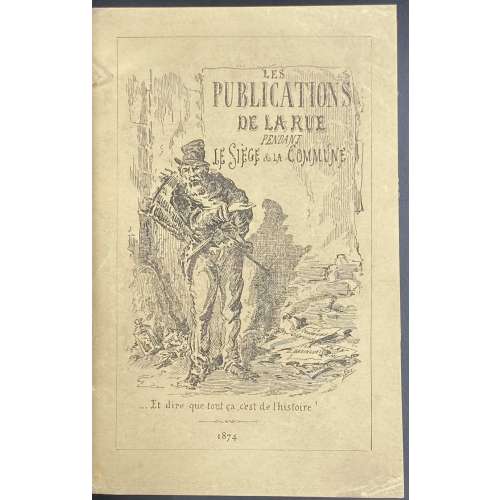 Convolute with three editions, dedicated to the Commune of Paris, 1871. (1) LES | Publications de la Rue | pendant | LE SIEGE ET LA COMMUNE | SATIRES — CANARDS — COMPLAINTES — CHANSONS | PLACARDS ET PAMPHLETS | BIBLIOGRAPHIE | PITTORESQUE ET ANECDOTIQUE | Par Firmin MAILLARD |{publisher’s device}| PARIS | AUGUSTE AUBRY, ÉDITEUR | 18, RUE SÉGUIER, 18 | 1874 || Pagination: ffl, original pictorial wrapper, [2] – blank / advert., [2] – h.t. / blank, [2] – h.t. / colophon imprim. PILLET FILS AINÉ, frontis. similar to front wrapper without '1874', [2] – t.p. / blank, [v] vi-xii, [1] 2-198, three blank leaves, back wrapper. (2) VILLE DE SAINT-DENIS | EXPOSITION D'ART & D'HISTOIRE | La Commune de Paris |18 Mars 1871 28 Mai | AVANT-PROPOS DE Lucien DESCAVES | de l’Académie Goncourt | PREFACE DE Jacques DORIOT | Député de la Seine, Maire de Saint-Denis | Du 17 Mars au 26 Mai 1935 | au Musée Municipal | 4, place de la Légion d’Honneur – Saint-Denis || Pagination: original pictorial wrapper in black and red, frontis., [2] - t.p. / blank, [2] – commité, v-xiii [xiv] 1-113 [114], 26 plates (13 leaves), blank back wrapper, spine tipped-in. (3) J. LEMONNYER | LES | JOURNAUX DE PARIS | PENDANT | LA COMMUNE | REVUE BIBLIOGRAPHIQUE COMPLETE | DE LA PRESSE PARISIENNE | du 19 Mars au 27 Mai | AVEC |{7 lines of text}| ET | UNE TABLE ALPHABÉTIQUE | DONNANT LE PRIX-COURANT DE CHAQUE COLLECTION | PARIS : J. LEMONNYER, Librarire | 73, Rue de Provence, 73 || Pagination: [2] - t.p. / blank, [2] – preface, [7] 8-94, green back wrapper w/advert., bfl. (lacks original front wrapper). Binding: Modern (20th century) red cloth, black label with gilt lettering to spine, matching marbled endpapers. Size: 18.5 x 13 cm; 12mo.
Convolute with three editions, dedicated to the Commune of Paris, 1871. (1) LES | Publications de la Rue | pendant | LE SIEGE ET LA COMMUNE | SATIRES — CANARDS — COMPLAINTES — CHANSONS | PLACARDS ET PAMPHLETS | BIBLIOGRAPHIE | PITTORESQUE ET ANECDOTIQUE | Par Firmin MAILLARD |{publisher’s device}| PARIS | AUGUSTE AUBRY, ÉDITEUR | 18, RUE SÉGUIER, 18 | 1874 || Pagination: ffl, original pictorial wrapper, [2] – blank / advert., [2] – h.t. / blank, [2] – h.t. / colophon imprim. PILLET FILS AINÉ, frontis. similar to front wrapper without '1874', [2] – t.p. / blank, [v] vi-xii, [1] 2-198, three blank leaves, back wrapper. (2) VILLE DE SAINT-DENIS | EXPOSITION D'ART & D'HISTOIRE | La Commune de Paris |18 Mars 1871 28 Mai | AVANT-PROPOS DE Lucien DESCAVES | de l’Académie Goncourt | PREFACE DE Jacques DORIOT | Député de la Seine, Maire de Saint-Denis | Du 17 Mars au 26 Mai 1935 | au Musée Municipal | 4, place de la Légion d’Honneur – Saint-Denis || Pagination: original pictorial wrapper in black and red, frontis., [2] - t.p. / blank, [2] – commité, v-xiii [xiv] 1-113 [114], 26 plates (13 leaves), blank back wrapper, spine tipped-in. (3) J. LEMONNYER | LES | JOURNAUX DE PARIS | PENDANT | LA COMMUNE | REVUE BIBLIOGRAPHIQUE COMPLETE | DE LA PRESSE PARISIENNE | du 19 Mars au 27 Mai | AVEC |{7 lines of text}| ET | UNE TABLE ALPHABÉTIQUE | DONNANT LE PRIX-COURANT DE CHAQUE COLLECTION | PARIS : J. LEMONNYER, Librarire | 73, Rue de Provence, 73 || Pagination: [2] - t.p. / blank, [2] – preface, [7] 8-94, green back wrapper w/advert., bfl. (lacks original front wrapper). Binding: Modern (20th century) red cloth, black label with gilt lettering to spine, matching marbled endpapers. Size: 18.5 x 13 cm; 12mo. -
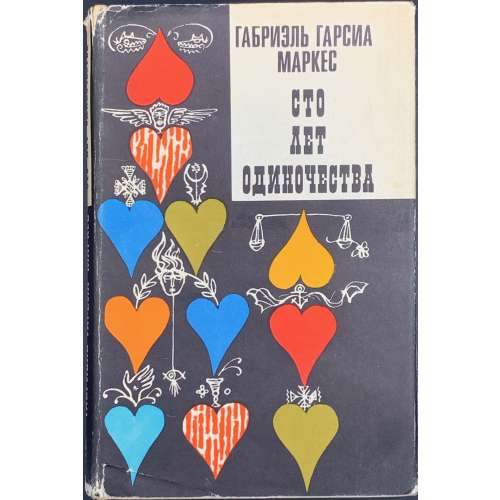 Hardcover, publisher's white cloth with a black imprint to cover, red and black lettering to spine, pictorial DJ, pp.: [1-4] 5-398 [2]. Послесловие В. Столбова, художник В. Юрлов. Russian translation of Cien años de soledad by Gabriel García Márquez.
Hardcover, publisher's white cloth with a black imprint to cover, red and black lettering to spine, pictorial DJ, pp.: [1-4] 5-398 [2]. Послесловие В. Столбова, художник В. Юрлов. Russian translation of Cien años de soledad by Gabriel García Márquez. -
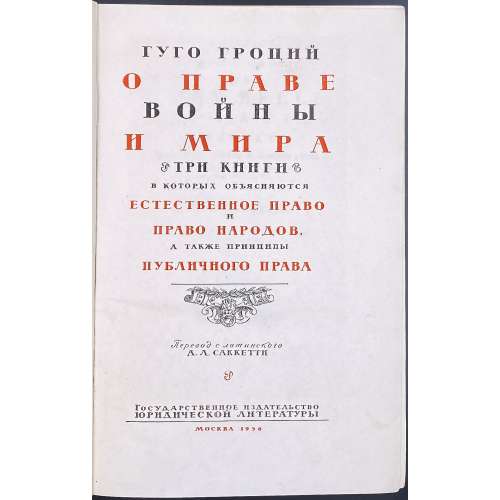 Title page (black and red): ГУГО ГРОЦИЙ | О ПРАВЕ | ВОЙНЫ | И МИРА | ß ТРИ КНИГИ ß | В КОТОРЫХ ОБЪЯСНЯЮТСЯ | ЕСТЕСТВЕННОЕ ПРАВО | И | ПРАВО НАРОДОВ, | А ТАКЖЕ ПРИНЦИПЫ | ПУБЛИЧНОГО ПРАВА | {device} | Перевод с латинского | А. Л. САККЕТТИ | Государственное издательство | ЮРИДИЧЕСКОЙ ЛИТЕРАТУРЫ | МОСКВА 1956 || Verso t.p.: Под общей редакцией профессора С. Б. КРЫЛОВА Pagination: [1, 2] – t.p. / editor, [3] 4-867 [868] – contents, errata slip, 4 plates extraneous to collation: frontis. portrait, t.p. Amsterdam edition of 1646, t.p. Russian edition of c. 1710, Lovensteyn castle. Collation: 8vo; [1]8 2-548 552. Binding: Publisher’s brown cloth, blind-stamped lettering to front board, elements of design in black and gilt lettering to spine. Вступительная статья А. А. Желудкова. Author: Hugo Grotius [Huig or Hugo de Groot] (Dutch, 1583 – 1645). Originally published by Nicolas Buon in Paris in 1625 in Latin under the title: De iure belli ac pacis (English: On the Law of War and Peace). Editor: Сергей Борисович Крылов (Russian, 1888 – 1958). Translator: Александр Ливериевич Саккетти (Russian, 1881 – 1966).
Title page (black and red): ГУГО ГРОЦИЙ | О ПРАВЕ | ВОЙНЫ | И МИРА | ß ТРИ КНИГИ ß | В КОТОРЫХ ОБЪЯСНЯЮТСЯ | ЕСТЕСТВЕННОЕ ПРАВО | И | ПРАВО НАРОДОВ, | А ТАКЖЕ ПРИНЦИПЫ | ПУБЛИЧНОГО ПРАВА | {device} | Перевод с латинского | А. Л. САККЕТТИ | Государственное издательство | ЮРИДИЧЕСКОЙ ЛИТЕРАТУРЫ | МОСКВА 1956 || Verso t.p.: Под общей редакцией профессора С. Б. КРЫЛОВА Pagination: [1, 2] – t.p. / editor, [3] 4-867 [868] – contents, errata slip, 4 plates extraneous to collation: frontis. portrait, t.p. Amsterdam edition of 1646, t.p. Russian edition of c. 1710, Lovensteyn castle. Collation: 8vo; [1]8 2-548 552. Binding: Publisher’s brown cloth, blind-stamped lettering to front board, elements of design in black and gilt lettering to spine. Вступительная статья А. А. Желудкова. Author: Hugo Grotius [Huig or Hugo de Groot] (Dutch, 1583 – 1645). Originally published by Nicolas Buon in Paris in 1625 in Latin under the title: De iure belli ac pacis (English: On the Law of War and Peace). Editor: Сергей Борисович Крылов (Russian, 1888 – 1958). Translator: Александр Ливериевич Саккетти (Russian, 1881 – 1966). -
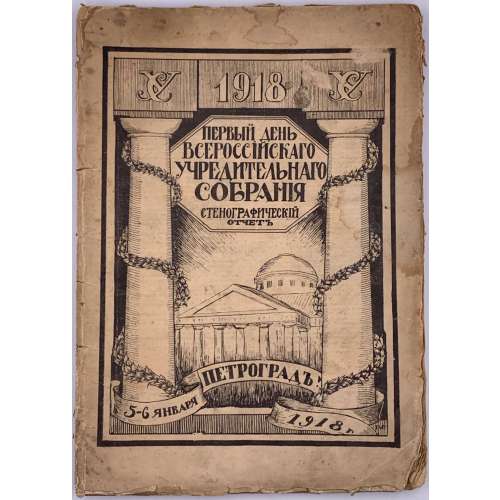 Cover: УС 1918 УС | ПЕРВЫЙ ДЕНЬ | ВСЕРОССIЙСКАГО | УЧРЕДИТЕЛЬНАГО | СОБРАНIЯ | СТЕНОГРАФИЧЕСКIЙ | ОТЧЕТЪ | 5-6 ЯНВАРЯ […] ПЕТРОГРАДЪ […] 1918 г. Title page: УЧРЕДИТЕЛЬНОЕ | СОБРАНIЕ | СТЕНОГРАФИЧЕСКIЙ ОТЧЕТЪ | ПЕЧАТАЕТСЯ ПО РАСПОРЯЖЕНIЮ ПРЕДСѢДАТЕЛЯ | УЧРЕДИТЕЛЬНАГО СОБРАНIЯ. | ПЕТРОГРАДЪ | Пятая Государственная типография, Стремянная, 12. | 1918. || Pencil inscription to t.p.: "Москва 1923 г. С. Варшавский". 23 x 16.5 cm, publisher’s pictorial wrappers, woodcut to front cover, pp.: [1-3] 4-112; collation: [1]8 2-78.
Cover: УС 1918 УС | ПЕРВЫЙ ДЕНЬ | ВСЕРОССIЙСКАГО | УЧРЕДИТЕЛЬНАГО | СОБРАНIЯ | СТЕНОГРАФИЧЕСКIЙ | ОТЧЕТЪ | 5-6 ЯНВАРЯ […] ПЕТРОГРАДЪ […] 1918 г. Title page: УЧРЕДИТЕЛЬНОЕ | СОБРАНIЕ | СТЕНОГРАФИЧЕСКIЙ ОТЧЕТЪ | ПЕЧАТАЕТСЯ ПО РАСПОРЯЖЕНIЮ ПРЕДСѢДАТЕЛЯ | УЧРЕДИТЕЛЬНАГО СОБРАНIЯ. | ПЕТРОГРАДЪ | Пятая Государственная типография, Стремянная, 12. | 1918. || Pencil inscription to t.p.: "Москва 1923 г. С. Варшавский". 23 x 16.5 cm, publisher’s pictorial wrappers, woodcut to front cover, pp.: [1-3] 4-112; collation: [1]8 2-78. -
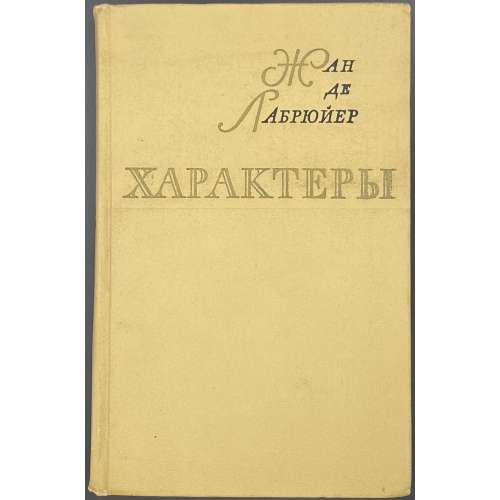 Жан де Лабрюйер | ХАРАКТЕРЫ, | ИЛИ | НРАВЫ | НЫНЕШНЕГО | ВЕКА | Перевод с французского | Э. ЛИНЕЦКОЙ И Ю. КОРНЕЕВА | ИЗДАТЕЛЬСТВО | «ХУДОЖЕСТВЕННАЯ ЛИТЕРАТУРА» | МОСКВА • ЛЕНИНГРАД | 1964 || Pagination: frontis., [2] 3-413 [414-416]; print run 50,000 copies. Collation : 8vo, [1]-268. Binding: 21 x 13.5 cm, olive buckram, lettering to cover and spine. Jean de La Bruyère (French, 1645 – 1696). Юрий Борисович Корнеев (Russian, 1921—1995). Эльга Львовна (Лейбовна) Линецкая [b. Фельдман] (Russian-Jewish, 1909 — 1997)
Жан де Лабрюйер | ХАРАКТЕРЫ, | ИЛИ | НРАВЫ | НЫНЕШНЕГО | ВЕКА | Перевод с французского | Э. ЛИНЕЦКОЙ И Ю. КОРНЕЕВА | ИЗДАТЕЛЬСТВО | «ХУДОЖЕСТВЕННАЯ ЛИТЕРАТУРА» | МОСКВА • ЛЕНИНГРАД | 1964 || Pagination: frontis., [2] 3-413 [414-416]; print run 50,000 copies. Collation : 8vo, [1]-268. Binding: 21 x 13.5 cm, olive buckram, lettering to cover and spine. Jean de La Bruyère (French, 1645 – 1696). Юрий Борисович Корнеев (Russian, 1921—1995). Эльга Львовна (Лейбовна) Линецкая [b. Фельдман] (Russian-Jewish, 1909 — 1997) -
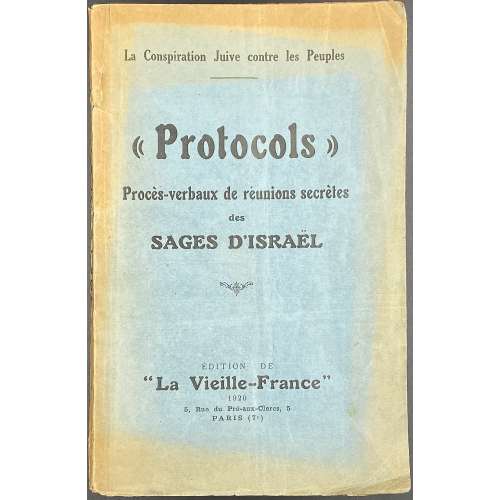 Cover: La Conspiration Juive contre les Peuples | « Protocols » | Procès-verbaux de réunions secrètes | des | SAGES D'ISRAËL | ÉDITION DE | “La Vieille-France” | 1920 | 5Rue du Pré-aux-Clercs, 5 | PARIS (7e) || Title: « Protocols » | Procès-verbaux de réunions secrètes | des | SAGES D'ISRAËL | ÉDITION DE | “La Vieille-France” | 1920 | 5Rue du Pré-aux-Clercs, 5 | PARIS (7e) || Pagination: [1, 2] – t.p. / blank, 3-141 [142 blank] [2] – table / blank. Pp.: 1-11 – Introduction; 13-82 – Protocols; 97-141 – Le Bolchevisme, c’est les Juifs. Collation : 8vo; [1]8 2-98. Binding: Publisher’s blue black-lettered wrappers, lettered spine. Printer: Imprimerie Chantenay (Paris). The French translation of "Протоколы синоских мудрецов" written in Russian by Сергей Нилус (Sergei Nilus, 1862 – 1929) was published in “La Vieille-France” by Urbain Gohier (1862 – 1951). Inside front wrapper: "Brave French! Please note that the format of this book allows you to hide it in your pockets. Your Jewish masters strictly forbid you to read it. Its existence is hidden in every possible way by the Jewish-controlled press. But fear not! While carefully hiding it, read carefully about what your Jewish masters forbid the newspapers to tell you. And you will understand – who and how will take your homeland away from you."
Cover: La Conspiration Juive contre les Peuples | « Protocols » | Procès-verbaux de réunions secrètes | des | SAGES D'ISRAËL | ÉDITION DE | “La Vieille-France” | 1920 | 5Rue du Pré-aux-Clercs, 5 | PARIS (7e) || Title: « Protocols » | Procès-verbaux de réunions secrètes | des | SAGES D'ISRAËL | ÉDITION DE | “La Vieille-France” | 1920 | 5Rue du Pré-aux-Clercs, 5 | PARIS (7e) || Pagination: [1, 2] – t.p. / blank, 3-141 [142 blank] [2] – table / blank. Pp.: 1-11 – Introduction; 13-82 – Protocols; 97-141 – Le Bolchevisme, c’est les Juifs. Collation : 8vo; [1]8 2-98. Binding: Publisher’s blue black-lettered wrappers, lettered spine. Printer: Imprimerie Chantenay (Paris). The French translation of "Протоколы синоских мудрецов" written in Russian by Сергей Нилус (Sergei Nilus, 1862 – 1929) was published in “La Vieille-France” by Urbain Gohier (1862 – 1951). Inside front wrapper: "Brave French! Please note that the format of this book allows you to hide it in your pockets. Your Jewish masters strictly forbid you to read it. Its existence is hidden in every possible way by the Jewish-controlled press. But fear not! While carefully hiding it, read carefully about what your Jewish masters forbid the newspapers to tell you. And you will understand – who and how will take your homeland away from you." -
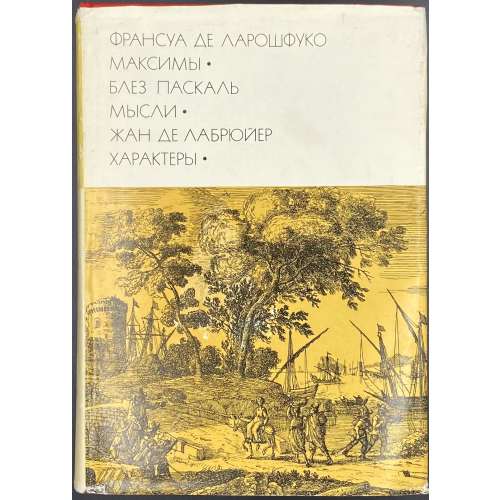 Title page: ФРАНСУА ДЕ ЛАРОШФУКО | МАКСИМЫ | • | БЛЕЗ ПАСКАЛЬ | МЫСЛИ | • | ЖАН ДЕ ЛАБРЮЙЕР | ХАРАКТЕРЫ | ПЕРЕВОД С ФРАНЦУЗСКОГО | {publisher’s device “ИХЛ”} | ИЗДАТЕЛЬСТВО | «ХУДОЖЕСТВЕННАЯ ЛИТЕРАТУРА» | МОСКВА • 1974 || Content: В. Бахмутский. / Французские моралисты. / Франсуа де Ларошфуко. Максимы. Пер. Э. Линецкой. / Блез Паскаль. Мысли. Пер. Э. Линецкой. / Жан де Лабрюйер. Характеры. Пер. Ю. Корнеева и Э. Линецкой. Примечания В. Бахмутского, И. Малевич, М. Разумовской, Т. Хатисовой. Pagination: [1-5] 5-541 [3], 13 illustrations (unpag.) Collation: [1]16 2-1716 + 13 photomechanical plates extraneous to collation. Binding: serial design red cloth, gilt-stamped cover with a serial device, gilt lettering to spine, pictorial dust jacket. Contributors: Blaise Pascal (French, 1623 – 1662) – author. François La Rochefoucauld (French, 1613 – 1680) – author. Jean de La Bruyère (French, 1645 – 1696) – author. Эльга Львовна [Лейбовна] Линецкая [Фельдман] (Russian-Jewish, 1909 – 1997) – translator. Юрий Борисович Корнеев (Russian, 1921 – 1995) – translator. Владимир Яковлевич Бахмутский (Russian, 1919 – 2004) – author/foreword.
Title page: ФРАНСУА ДЕ ЛАРОШФУКО | МАКСИМЫ | • | БЛЕЗ ПАСКАЛЬ | МЫСЛИ | • | ЖАН ДЕ ЛАБРЮЙЕР | ХАРАКТЕРЫ | ПЕРЕВОД С ФРАНЦУЗСКОГО | {publisher’s device “ИХЛ”} | ИЗДАТЕЛЬСТВО | «ХУДОЖЕСТВЕННАЯ ЛИТЕРАТУРА» | МОСКВА • 1974 || Content: В. Бахмутский. / Французские моралисты. / Франсуа де Ларошфуко. Максимы. Пер. Э. Линецкой. / Блез Паскаль. Мысли. Пер. Э. Линецкой. / Жан де Лабрюйер. Характеры. Пер. Ю. Корнеева и Э. Линецкой. Примечания В. Бахмутского, И. Малевич, М. Разумовской, Т. Хатисовой. Pagination: [1-5] 5-541 [3], 13 illustrations (unpag.) Collation: [1]16 2-1716 + 13 photomechanical plates extraneous to collation. Binding: serial design red cloth, gilt-stamped cover with a serial device, gilt lettering to spine, pictorial dust jacket. Contributors: Blaise Pascal (French, 1623 – 1662) – author. François La Rochefoucauld (French, 1613 – 1680) – author. Jean de La Bruyère (French, 1645 – 1696) – author. Эльга Львовна [Лейбовна] Линецкая [Фельдман] (Russian-Jewish, 1909 – 1997) – translator. Юрий Борисович Корнеев (Russian, 1921 – 1995) – translator. Владимир Яковлевич Бахмутский (Russian, 1919 – 2004) – author/foreword. -
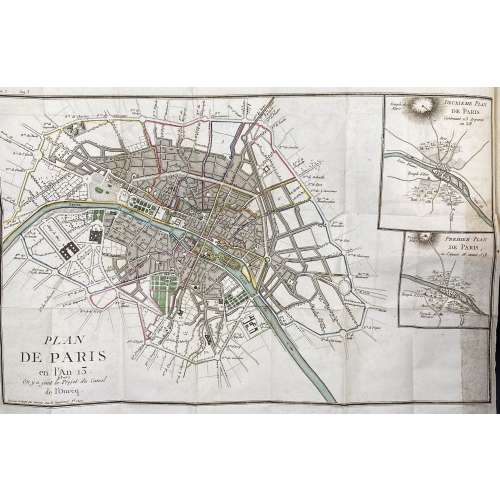 Two volumes, 12mo; 14 x 9 cm, uniformly bound in speckled calf with dentelle border in gilt, gilt-stamped spine with two crimson lettered labels, marbled endpapers. Inscription to h.t.: P. Leigh Smith | Moscow | 1921 || Vol. 1: Half-title: MIROIR | DE L'ANCIEN ET DU NOUVEAU | PARIS, | AVEC TREIZE VOYAGES | EN VÉLOCIFÈRES, |DANS SES ENVIRONS. | TOME I. || Title page: MIROIR | DE L'ANCIEN ET DU NOUVEAU | PARIS, | AVEC TREIZE VOYAGES | EN VÉLOCIFÈRES, |DANS SES ENVIRONS. Ouvrage indespensable aus Étrangers et même | aux Parisiens, et qui indique tout ce qu’il faut | connoître et éviter dans cette capitale. | Orné d’un Plan de Paris et de 18 Gravures | {to the right, in single rules} Tels temps, telles mœurs. | Par L. Prudhomme. | Tome I. | PARIS, | PRUDHOMME, fils, rue des Marais, F. B. St.-G. | DEBRAY, rue St. Honoré, barrière des Sergens. | AN XIII. — (1804.) || Pagination: [i-vii] viii-xxxvi, 1-260; total 296 pages + 15 copperplate engravings and 1 folding plan of Paris. Collation: πA-πC6, A-C6, 4-216 224; total 148 leaves + 15 plates + 1 folding. Note: 12mo; πA1 unsigned, A2 unsigned, A–C3 signed A-C5, respectively, 4* unsigned, 9* marked 8*, 18* marked 17*. Vol. 2: Similar half-title and title, TOME II instead of TOME I. Pagination: [4] 1-408; total 412 pages + 3 copperplate engravings. Collation: π2, 1-346; total 206 leaves + 3 plates.
Two volumes, 12mo; 14 x 9 cm, uniformly bound in speckled calf with dentelle border in gilt, gilt-stamped spine with two crimson lettered labels, marbled endpapers. Inscription to h.t.: P. Leigh Smith | Moscow | 1921 || Vol. 1: Half-title: MIROIR | DE L'ANCIEN ET DU NOUVEAU | PARIS, | AVEC TREIZE VOYAGES | EN VÉLOCIFÈRES, |DANS SES ENVIRONS. | TOME I. || Title page: MIROIR | DE L'ANCIEN ET DU NOUVEAU | PARIS, | AVEC TREIZE VOYAGES | EN VÉLOCIFÈRES, |DANS SES ENVIRONS. Ouvrage indespensable aus Étrangers et même | aux Parisiens, et qui indique tout ce qu’il faut | connoître et éviter dans cette capitale. | Orné d’un Plan de Paris et de 18 Gravures | {to the right, in single rules} Tels temps, telles mœurs. | Par L. Prudhomme. | Tome I. | PARIS, | PRUDHOMME, fils, rue des Marais, F. B. St.-G. | DEBRAY, rue St. Honoré, barrière des Sergens. | AN XIII. — (1804.) || Pagination: [i-vii] viii-xxxvi, 1-260; total 296 pages + 15 copperplate engravings and 1 folding plan of Paris. Collation: πA-πC6, A-C6, 4-216 224; total 148 leaves + 15 plates + 1 folding. Note: 12mo; πA1 unsigned, A2 unsigned, A–C3 signed A-C5, respectively, 4* unsigned, 9* marked 8*, 18* marked 17*. Vol. 2: Similar half-title and title, TOME II instead of TOME I. Pagination: [4] 1-408; total 412 pages + 3 copperplate engravings. Collation: π2, 1-346; total 206 leaves + 3 plates. -
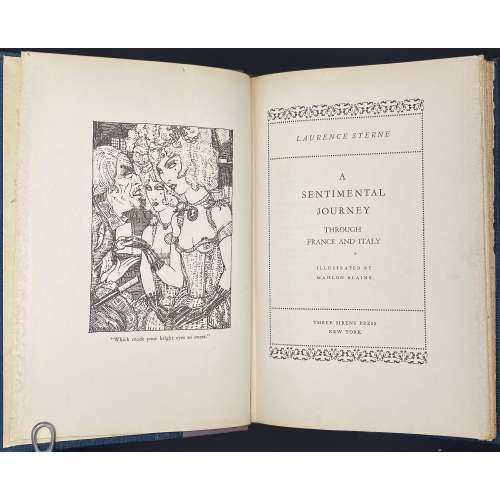 Title page (frame, three compartments: LAURENCE STERNE |—| A | SENTIMENTAL | JOURNEY | THROUGH | FRANCE AND ITALY | ILLUSTRATED BY | MAHLON BLAINE |—| THREE SIRENS PRESS | NEW YORK || Title verso: (top) COPYRIGHT, 1930, BY WILLIAMS, BELASCO & MEYERS | PRINTED IN THE UNITED STATES OF AMERICA | (bottom) BY J. J. LITTLE & IVES COMPANY, NEW YORK || Pagination: [1-6] 7-192, frontispiece, headpiece, and 4 plates within collation (pp. 45, 85, 141, and 185) after Blaine’s pen drawings in the woodcut manner. Binding: quarter lilac morocco with stamped brown lettering over blue cloth, design elements and lettering to spine, top edge gilt, fore-edge untrimmed. Size: 24.5 x 16 cm Edition: presumably 1st edition with plates after Blaine. Contributors: Sterne, Laurence (British-Irish, 1713 – 1768) – author of the text. Blaine, Mahlon (American, 1894 – 1969) – illustrator (pseudonym: G. Christopher Hudson). Three Sirens Press (NY); Williams, Belasco, and Meyers (NY) – publishers. J. J. Little & Ives Company (NY) – printer. Compare to the re-printed edition by Halcyon House, [c. 1950] in the collection [LIB-2783.2021].
Title page (frame, three compartments: LAURENCE STERNE |—| A | SENTIMENTAL | JOURNEY | THROUGH | FRANCE AND ITALY | ILLUSTRATED BY | MAHLON BLAINE |—| THREE SIRENS PRESS | NEW YORK || Title verso: (top) COPYRIGHT, 1930, BY WILLIAMS, BELASCO & MEYERS | PRINTED IN THE UNITED STATES OF AMERICA | (bottom) BY J. J. LITTLE & IVES COMPANY, NEW YORK || Pagination: [1-6] 7-192, frontispiece, headpiece, and 4 plates within collation (pp. 45, 85, 141, and 185) after Blaine’s pen drawings in the woodcut manner. Binding: quarter lilac morocco with stamped brown lettering over blue cloth, design elements and lettering to spine, top edge gilt, fore-edge untrimmed. Size: 24.5 x 16 cm Edition: presumably 1st edition with plates after Blaine. Contributors: Sterne, Laurence (British-Irish, 1713 – 1768) – author of the text. Blaine, Mahlon (American, 1894 – 1969) – illustrator (pseudonym: G. Christopher Hudson). Three Sirens Press (NY); Williams, Belasco, and Meyers (NY) – publishers. J. J. Little & Ives Company (NY) – printer. Compare to the re-printed edition by Halcyon House, [c. 1950] in the collection [LIB-2783.2021].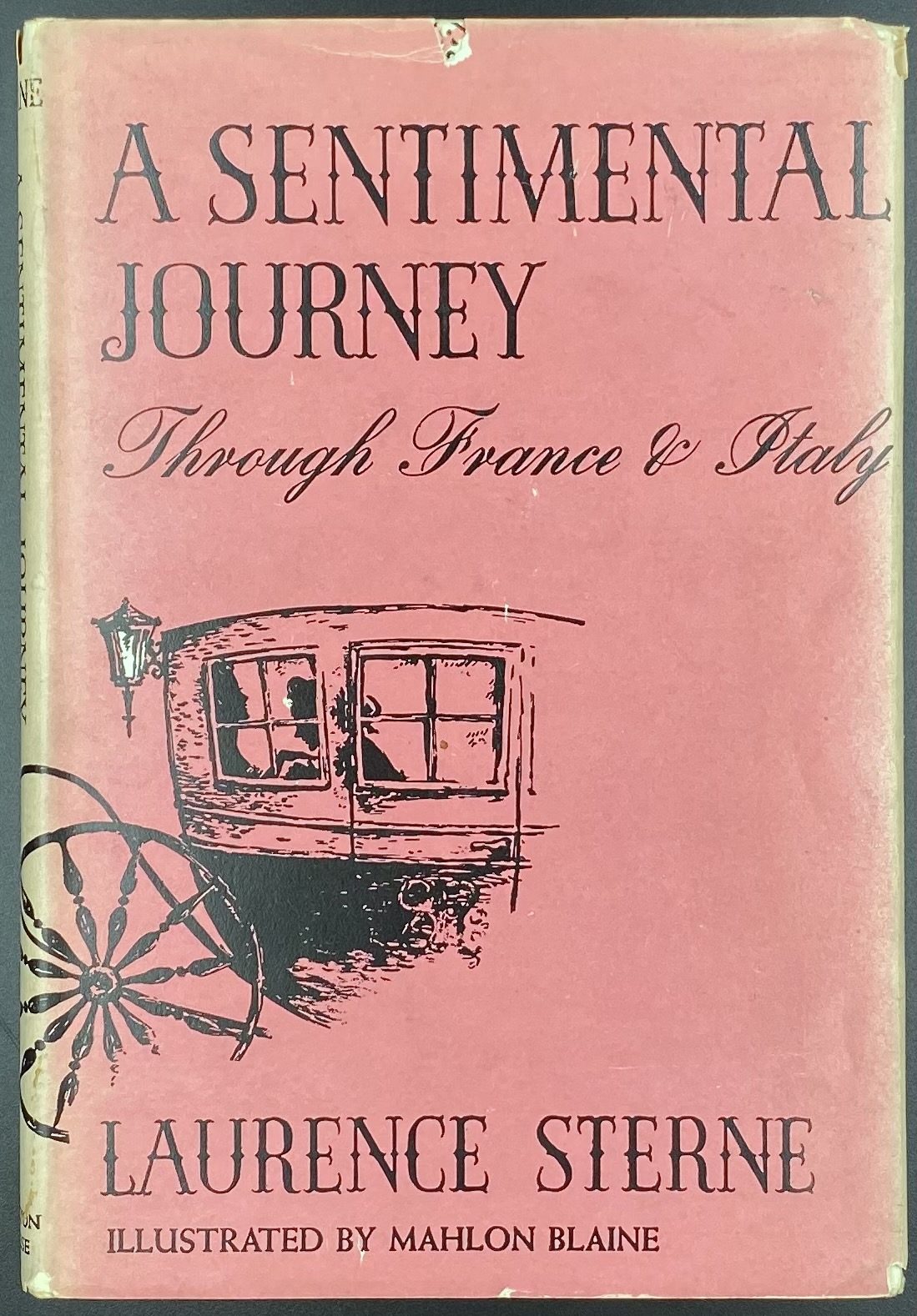 As stated, the copyright is held by Williams, Belasco, and Meyers, who are: Joseph Meyers (c. 1898 – 1957), his sister Edna Williams, and David Belasco (1853 – 1931). "Joseph Meyers was described by Bennet Cerf (Modern Library, Random House) as a “notorious pirate” in Gertzman’s book Bookleggers and Smuthounds, and the trio of presses allegedly indulged in reprinting numerous books without holding the copyright to those titles. By not paying copyright fees, Meyers and Williams were able to print and sell good quality illustrated books at prices that were below typical smaller, unillustrated reprint series of the 1930s." [cit.]
As stated, the copyright is held by Williams, Belasco, and Meyers, who are: Joseph Meyers (c. 1898 – 1957), his sister Edna Williams, and David Belasco (1853 – 1931). "Joseph Meyers was described by Bennet Cerf (Modern Library, Random House) as a “notorious pirate” in Gertzman’s book Bookleggers and Smuthounds, and the trio of presses allegedly indulged in reprinting numerous books without holding the copyright to those titles. By not paying copyright fees, Meyers and Williams were able to print and sell good quality illustrated books at prices that were below typical smaller, unillustrated reprint series of the 1930s." [cit.]
-
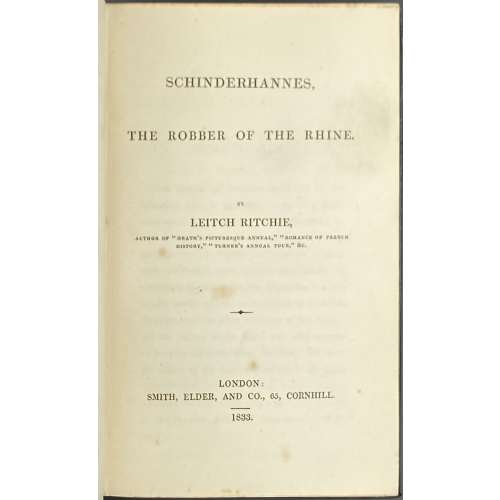 Serial title: THE | LIBRARY OF ROMANCE. | EDITED | BY LEITCH RITCHIE. | VOL. II. | — | SCHINDERHANNES, | THE ROBBER OF THE RHINE. | BY THE EDITOR. | — | LONDON: | SMITH, ELDER, AND CO., 65, CORNHILL. | — | 1833. || Title page: SCHINDERHANNES, | THE ROBBER OF THE RHINE. | BY | LEITCH RITCHIE, | AUTHOR OF “HEATH’S PICTURESQUE ANNUAL,” “ROMANCE OF FRENCH | HISTORY,” “TURNER’S ANNUAL TOUR,” &c. | — | LONDON: | SMITH, ELDER, AND CO., 65, CORNHILL. | — | 1833. || Pagination: [1] 2 – prospectus, [i, ii] – serial title / imprint, [iii-iv] – t.p. / blank, [v] vi (mispaged iv) – advert. [vii] viii – contents, [2] f.t. / blank; [1] 2-314 – text, [2] – advert. vol. I and III; total number of pages 12+314+2=328 Collation: 8vo; π6 B-U8 X4 Y2, total number of leaves 164. Binding: 18 x 11.5 cm, dark green buckram (faux morocco), gilt lettering and design elements to spine, printer’s imprint to π4: Bradbury and Evans, moiré endpapers. Cat. raisonné: Sadleir (v.2) 3760a, p. 171. Contributors: Leitch Ritchie (British-Scottish, 1800 – 1865) – author. Schinderhannes [Johannes Bückler] (German, c.1778 – 1803) – character. Bradbury & Evans (est.1830) – printer. Smith, Elder, and Company (1816 - 1917) – publisher. George Smith (British-Scottish, 1789 – 1846) – publisher. George Murray Smith (British, 1824 – 1901) – publisher. Alexander Elder (British, 1790 – 1876) – publisher.
Serial title: THE | LIBRARY OF ROMANCE. | EDITED | BY LEITCH RITCHIE. | VOL. II. | — | SCHINDERHANNES, | THE ROBBER OF THE RHINE. | BY THE EDITOR. | — | LONDON: | SMITH, ELDER, AND CO., 65, CORNHILL. | — | 1833. || Title page: SCHINDERHANNES, | THE ROBBER OF THE RHINE. | BY | LEITCH RITCHIE, | AUTHOR OF “HEATH’S PICTURESQUE ANNUAL,” “ROMANCE OF FRENCH | HISTORY,” “TURNER’S ANNUAL TOUR,” &c. | — | LONDON: | SMITH, ELDER, AND CO., 65, CORNHILL. | — | 1833. || Pagination: [1] 2 – prospectus, [i, ii] – serial title / imprint, [iii-iv] – t.p. / blank, [v] vi (mispaged iv) – advert. [vii] viii – contents, [2] f.t. / blank; [1] 2-314 – text, [2] – advert. vol. I and III; total number of pages 12+314+2=328 Collation: 8vo; π6 B-U8 X4 Y2, total number of leaves 164. Binding: 18 x 11.5 cm, dark green buckram (faux morocco), gilt lettering and design elements to spine, printer’s imprint to π4: Bradbury and Evans, moiré endpapers. Cat. raisonné: Sadleir (v.2) 3760a, p. 171. Contributors: Leitch Ritchie (British-Scottish, 1800 – 1865) – author. Schinderhannes [Johannes Bückler] (German, c.1778 – 1803) – character. Bradbury & Evans (est.1830) – printer. Smith, Elder, and Company (1816 - 1917) – publisher. George Smith (British-Scottish, 1789 – 1846) – publisher. George Murray Smith (British, 1824 – 1901) – publisher. Alexander Elder (British, 1790 – 1876) – publisher. -
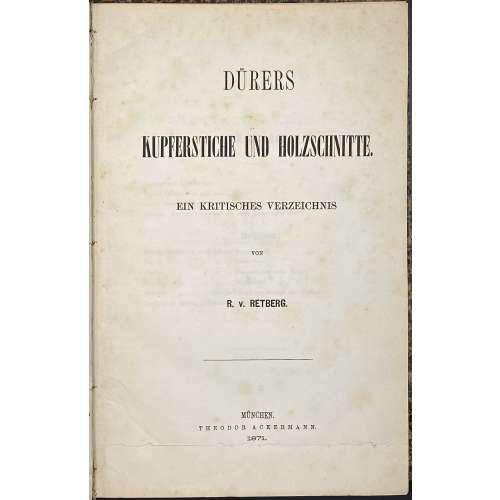 Publisher’s blue wrapper: DÜRERS | KUPFERSTICHE UND HOLZSCHNITTE. | EIN KRITISCHES VERZEICHNIS | VON | R. v. RETBERG. | MÜNCHEN. | THEODOR ACKERMANN. | 1871. || Title page: similar to front wrapper, 2.5 cm cut at the bottom, text not affected. Pagination: front wrapper with lettering in a frame, flyleaf, [4] 1-169 [170 blank] [2], flyleaf, back wrapper with imprint plus 2 plates (frontis., Il. entry №129, and op. p., il. entry 100 № 260, printed on laid paper without watermark). Collation: π2 1-88 9-134 142, plus 2 plates extraneous to collation, incl. frontispiece. Binding: 26.4 x 17.5 cm, quarter green morocco over marbled boards, black compartment fillets and lettering to spine, publisher’s wrappers preserved. Marks: bookplate 6 x 9 cm to front pastedown: “БИБЛИОТЕКА | ГОСУДАРСТВЕННОГО | ЭРМИТАЖА ИЗ СОБРАНИЯ | СТЕПАНА ПЕТРОВИЧА | ЯРЕМИЧА | (1869 – 1939)”, purple ink stamp “В ПРОДАЖУ”. To front wrapper: Ink manuscript on top “Dr. Lichtenstein”… etc., black ink seal of rampant lion and pencil number “949” in the middle; pencil marks to p. 162.
Publisher’s blue wrapper: DÜRERS | KUPFERSTICHE UND HOLZSCHNITTE. | EIN KRITISCHES VERZEICHNIS | VON | R. v. RETBERG. | MÜNCHEN. | THEODOR ACKERMANN. | 1871. || Title page: similar to front wrapper, 2.5 cm cut at the bottom, text not affected. Pagination: front wrapper with lettering in a frame, flyleaf, [4] 1-169 [170 blank] [2], flyleaf, back wrapper with imprint plus 2 plates (frontis., Il. entry №129, and op. p., il. entry 100 № 260, printed on laid paper without watermark). Collation: π2 1-88 9-134 142, plus 2 plates extraneous to collation, incl. frontispiece. Binding: 26.4 x 17.5 cm, quarter green morocco over marbled boards, black compartment fillets and lettering to spine, publisher’s wrappers preserved. Marks: bookplate 6 x 9 cm to front pastedown: “БИБЛИОТЕКА | ГОСУДАРСТВЕННОГО | ЭРМИТАЖА ИЗ СОБРАНИЯ | СТЕПАНА ПЕТРОВИЧА | ЯРЕМИЧА | (1869 – 1939)”, purple ink stamp “В ПРОДАЖУ”. To front wrapper: Ink manuscript on top “Dr. Lichtenstein”… etc., black ink seal of rampant lion and pencil number “949” in the middle; pencil marks to p. 162.Contents: Inhalt - Berichtigungen - Vorwort und Einleitendes - Dürers Lebenskizze - [Text] - Nachtrag zu Dürers "Lebenskizze". A critical directory of Albrecht Dürer (German, 1471 – 1528) copperplate engravings and woodcuts by Ralf von Retberg (German, 1812 – 1885): the description of 167 woodcuts and 103 copperplate engravings.
Provenance: From the collection of a Russian artist Stepan Petrovich Yaremich, sold by Hermitage Museum in St. Petersburg. Ref: Royal Academy. -
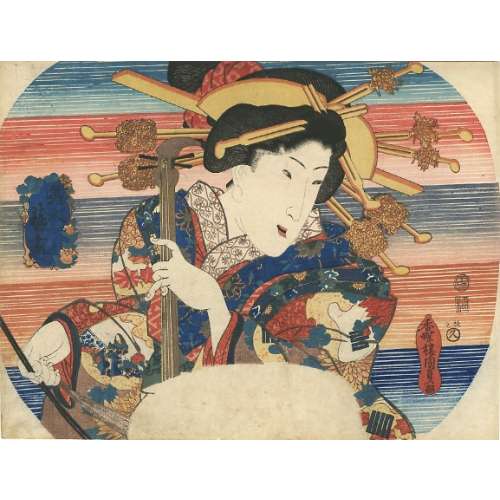 A young woman playing a four-string musical instrument with a bow (kokyū). Series: Assortments of Beauties Accomplishments [美人芸盡] (Bijin gei-zukushi). Utagawa Kunisada [歌川 国貞]; a.k.a. Utagawa Toyokuni III [三代歌川豊国] (Japanese, 1786 – 1865). Signed: Kochoro Kunisada ga [香蝶楼 国貞画] in a red double gourd cartouche. Publisher: Ibaya Kyūbei [伊場屋久兵衛] (Japanese, 1804 – 1851); seal: Hanmoto, Kyū [板元久] (Marks 19-040 | 126e) Date seal: Bunsei 12 (1829). Censors' seal: Kiwame. Size: Fan print (uchiwa-e).
A young woman playing a four-string musical instrument with a bow (kokyū). Series: Assortments of Beauties Accomplishments [美人芸盡] (Bijin gei-zukushi). Utagawa Kunisada [歌川 国貞]; a.k.a. Utagawa Toyokuni III [三代歌川豊国] (Japanese, 1786 – 1865). Signed: Kochoro Kunisada ga [香蝶楼 国貞画] in a red double gourd cartouche. Publisher: Ibaya Kyūbei [伊場屋久兵衛] (Japanese, 1804 – 1851); seal: Hanmoto, Kyū [板元久] (Marks 19-040 | 126e) Date seal: Bunsei 12 (1829). Censors' seal: Kiwame. Size: Fan print (uchiwa-e). -

"In the olive grove", etching on laid paper. Signed on the plate and inscribed "L'olivierade Monaco, 76" (sic.). Owner's stamp LvM on verso.
Dimensions: Paper: 44 x 30.5 cm; Plate: 40 x 27 cm; Image: 35 x 24.5 cm.
Catalogue raisonné: Arthur Hubschmid (1977): 323; Graphics irreverent and erotic (1968): 323.
-
 Top: THE ENVIRONS OF PARIS. || Bottom centre: Published by Baldwin & Cradock, Paternoster Row, | Under the Superintendence of the Society for the Diffusion of Useful Knowledge. | March 1st. 1832. || Bottom right: J. & C. Walker sculpt. || Dimensions: Sheet: 34.7 x 40.5 cm; Image: 30 x 37 cm. Contributors: J & C Walker (British firm, fl. 1820 – 1895) Walker, John (British, 1787 – 1873) Walker, Alexander (British, 1797? – 1870) Walker, Charles (British, 1799? – 1872) Society for the Diffusion of Useful Knowledge (SDUK) (British firm, 1826 – 1846)
Top: THE ENVIRONS OF PARIS. || Bottom centre: Published by Baldwin & Cradock, Paternoster Row, | Under the Superintendence of the Society for the Diffusion of Useful Knowledge. | March 1st. 1832. || Bottom right: J. & C. Walker sculpt. || Dimensions: Sheet: 34.7 x 40.5 cm; Image: 30 x 37 cm. Contributors: J & C Walker (British firm, fl. 1820 – 1895) Walker, John (British, 1787 – 1873) Walker, Alexander (British, 1797? – 1870) Walker, Charles (British, 1799? – 1872) Society for the Diffusion of Useful Knowledge (SDUK) (British firm, 1826 – 1846) -
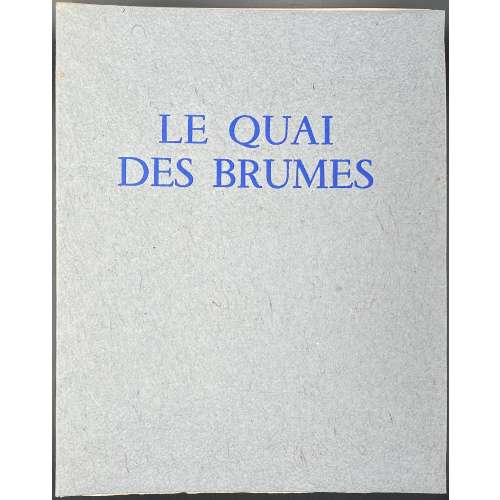 Description: One volume in-4to, 28.7 x 23 cm, in a grey double slipcase 29.6 x 24 cm, lettered paper label to spine, in publisher’s original French flapped blue wrappers, lettered on front, unbound, printed on thick wove paper watermarked "PUR FIL MARAIS". Illustrated with coloured two full-page plates and numerous in-text images, head- and tailpieces engraved by F. Nourisson after André Dignimont. Title-page (blue and black): PIERRE MAC ORLAN | LE QUAI | DES BRUMES | ILLUSTRATIONS DE | DIGNIMONT | ÉDITIONS ARC-EN-CIEL | M CM XLVIII || Pagination: [1-4] (h.t./frontis., t.p./copyright, 5-157 [158] [8] (plate, limit., colophon, blank); total 166 pages. Limitation: Printed in December 1948, engravings on Padovani press and text by Vibert. The edition is limited to 250 copies, № 1 unique on Japon nacré + original drawings and one suite, 28 copies (№ 2-29) on Vélin d’Arches + one drawing and one suite, 51 copies (№ 30-80) on Vélin de Lana + one suite, 170 copies (№ 81-250) on Vélin pur fil des Papeteries du Marais, 10 copies (№ I-X) on different papers for collaborators. This copy is № 115. Ref: WorldCat. Pierre Mac-Orlan (French, 1882 – 1970) – author. André Dignimont (French, 1891 – 1965) – artist.
Description: One volume in-4to, 28.7 x 23 cm, in a grey double slipcase 29.6 x 24 cm, lettered paper label to spine, in publisher’s original French flapped blue wrappers, lettered on front, unbound, printed on thick wove paper watermarked "PUR FIL MARAIS". Illustrated with coloured two full-page plates and numerous in-text images, head- and tailpieces engraved by F. Nourisson after André Dignimont. Title-page (blue and black): PIERRE MAC ORLAN | LE QUAI | DES BRUMES | ILLUSTRATIONS DE | DIGNIMONT | ÉDITIONS ARC-EN-CIEL | M CM XLVIII || Pagination: [1-4] (h.t./frontis., t.p./copyright, 5-157 [158] [8] (plate, limit., colophon, blank); total 166 pages. Limitation: Printed in December 1948, engravings on Padovani press and text by Vibert. The edition is limited to 250 copies, № 1 unique on Japon nacré + original drawings and one suite, 28 copies (№ 2-29) on Vélin d’Arches + one drawing and one suite, 51 copies (№ 30-80) on Vélin de Lana + one suite, 170 copies (№ 81-250) on Vélin pur fil des Papeteries du Marais, 10 copies (№ I-X) on different papers for collaborators. This copy is № 115. Ref: WorldCat. Pierre Mac-Orlan (French, 1882 – 1970) – author. André Dignimont (French, 1891 – 1965) – artist. -
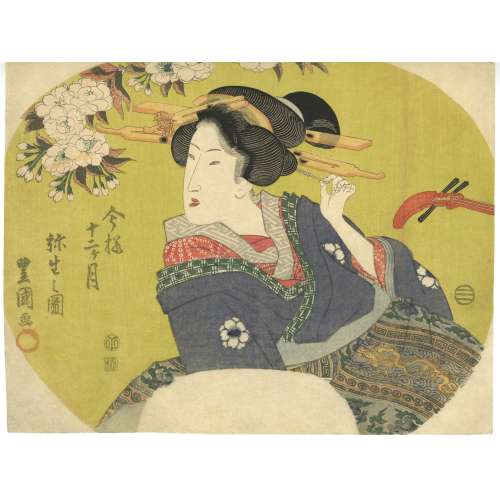 Title: Third lunar month [弥生] (Yayoi no zu); Series: Fashionable Twelve Months (Imayo juni-kagetsu). Another version of translation: Modern Beauties of Twelve Months. Artist: Utagawa Toyokuni I [歌川豊国] (1769–1825). Pubisher: Ibaya Senzaburō [伊場屋仙三郎] (Japanese, 1815 – 1869), seal: Dansendō [伊場仙]. Signed: Toyokuni ga and sealed with toshidama. Date-kiwame seal: Ushi (ox), Bunsei 5 (1822). Size: double-sheet uncut fan print ( aiban uchiwa-e), 219 x 295 mm.
Title: Third lunar month [弥生] (Yayoi no zu); Series: Fashionable Twelve Months (Imayo juni-kagetsu). Another version of translation: Modern Beauties of Twelve Months. Artist: Utagawa Toyokuni I [歌川豊国] (1769–1825). Pubisher: Ibaya Senzaburō [伊場屋仙三郎] (Japanese, 1815 – 1869), seal: Dansendō [伊場仙]. Signed: Toyokuni ga and sealed with toshidama. Date-kiwame seal: Ushi (ox), Bunsei 5 (1822). Size: double-sheet uncut fan print ( aiban uchiwa-e), 219 x 295 mm.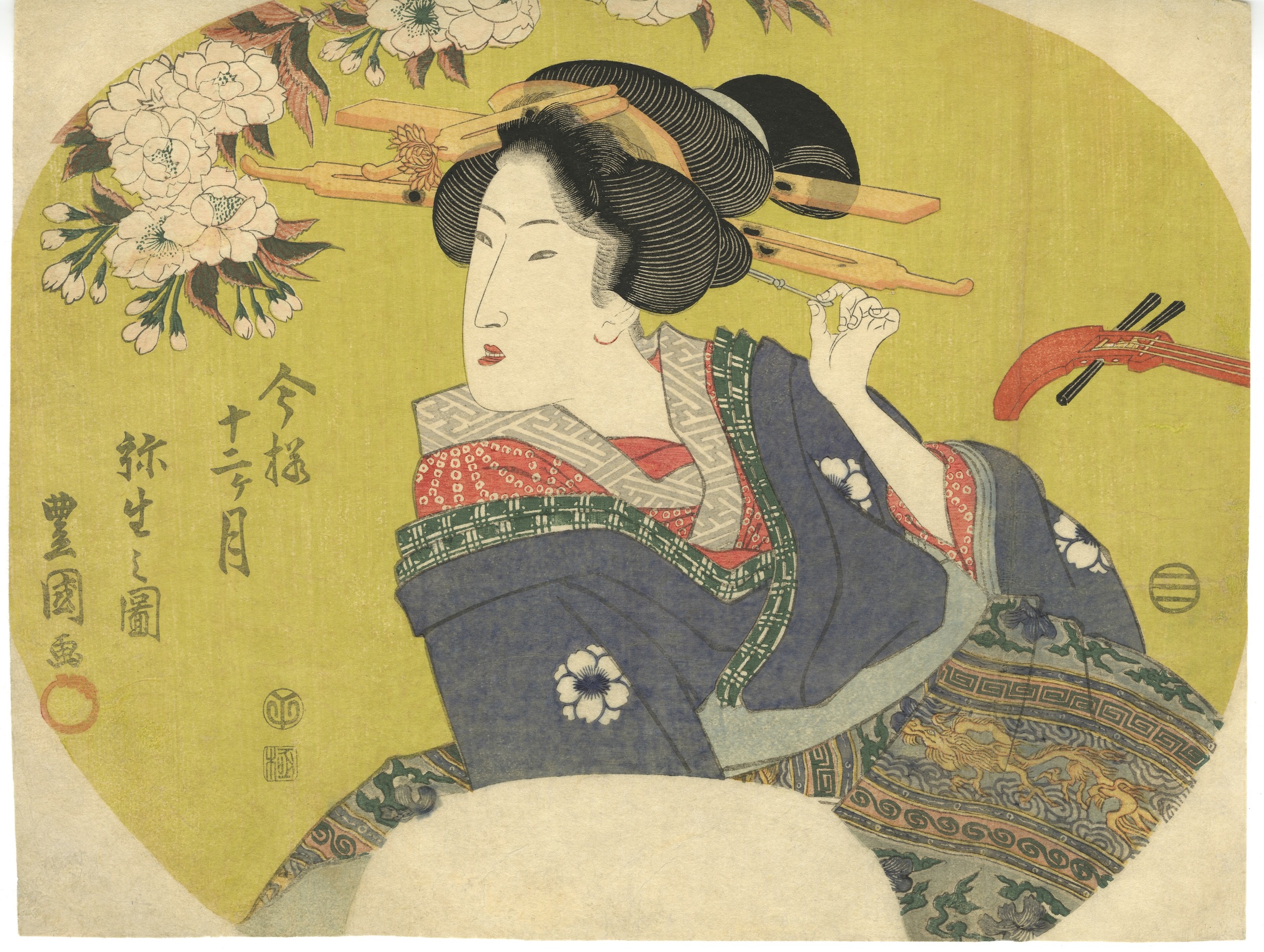
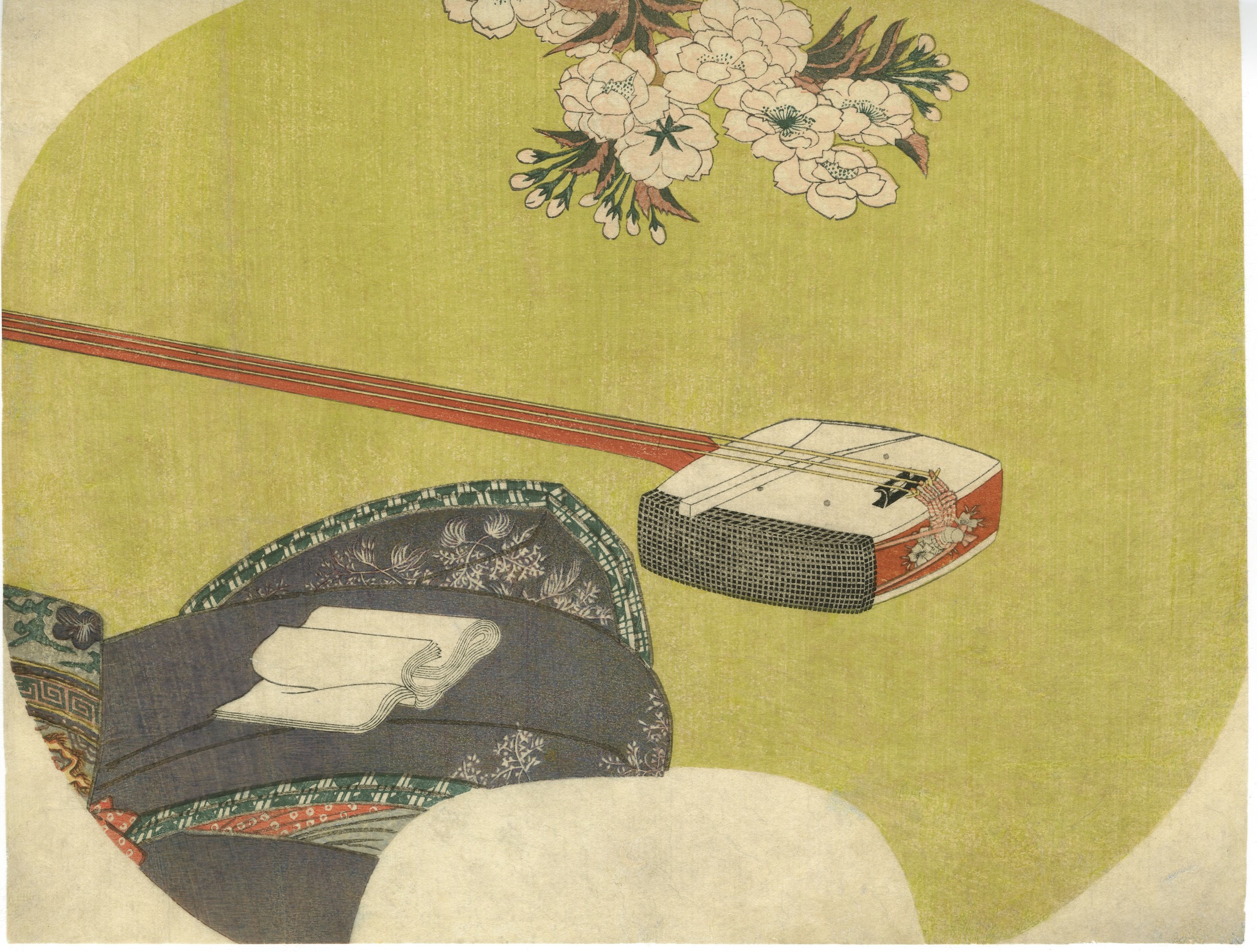
-
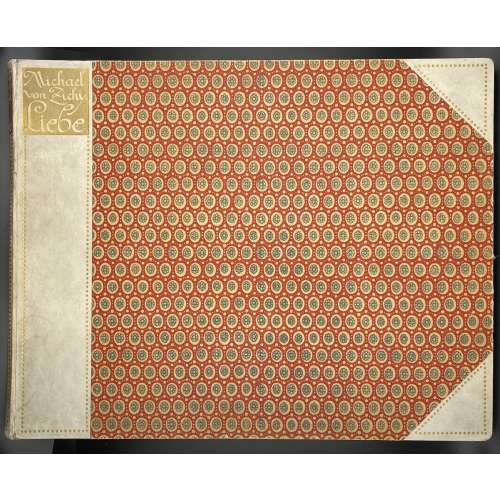 Oblong album of forty photogravures printed on wove paper in sanguine after drawings by Mihály Zichy; 31.5 x 40.5 cm gilt-decorated half-parchment over red boards with a gilt diaper design; embossed gilt label in the top left corner “Michael | von Zichy. | Liebe”. Anonymous edition. Bookplate to front pastedown: “P•U•H | EX | LIBRIS”. Photogravures made from the original watercolours and crayon drawings produced in 1874-1879; the original album consisted of 51 compositions was sold at Christie’s sale of Gérard Nordmann collection on December 14-15, 2006 in Paris. Some of these photogravures were reproduced photomechanically and printed in 1869 [LIB-2244.2019] and 1989 [LIB-2242.2019]. Limitation: 300 copies were privately printed in Leipzig in 1911 for subscribers only; photogravure copper plates were destroyed. This is copy № 285. Title-page (brown and black): MICHAEL VON ZICHY | LIEBE | VIERZIG ZEICHNUNGEN | PRIVATDRUCK LEIPZIG 1911 || Dimensions: album: 31.5 x 40.5 cm; sheets 31 x 40 cm, uncut. Catalogue raisonné: Bibliothèque érotique: Gérard Nordmann; Livres, manuscrits, dessins, photographies du XVIe au XXe siècle / Catalogues de ventes, seconde partie. — Paris: Christie’s, 2006; p. 280, № 564 (drawings); № 565 photogravures [LIB-2810.2021]. Contributors: Mihály Zichy [Michael von Zichy; Михаил Александрович Зичи] (Hungarian, 1827 – 1906).
Oblong album of forty photogravures printed on wove paper in sanguine after drawings by Mihály Zichy; 31.5 x 40.5 cm gilt-decorated half-parchment over red boards with a gilt diaper design; embossed gilt label in the top left corner “Michael | von Zichy. | Liebe”. Anonymous edition. Bookplate to front pastedown: “P•U•H | EX | LIBRIS”. Photogravures made from the original watercolours and crayon drawings produced in 1874-1879; the original album consisted of 51 compositions was sold at Christie’s sale of Gérard Nordmann collection on December 14-15, 2006 in Paris. Some of these photogravures were reproduced photomechanically and printed in 1869 [LIB-2244.2019] and 1989 [LIB-2242.2019]. Limitation: 300 copies were privately printed in Leipzig in 1911 for subscribers only; photogravure copper plates were destroyed. This is copy № 285. Title-page (brown and black): MICHAEL VON ZICHY | LIEBE | VIERZIG ZEICHNUNGEN | PRIVATDRUCK LEIPZIG 1911 || Dimensions: album: 31.5 x 40.5 cm; sheets 31 x 40 cm, uncut. Catalogue raisonné: Bibliothèque érotique: Gérard Nordmann; Livres, manuscrits, dessins, photographies du XVIe au XXe siècle / Catalogues de ventes, seconde partie. — Paris: Christie’s, 2006; p. 280, № 564 (drawings); № 565 photogravures [LIB-2810.2021]. Contributors: Mihály Zichy [Michael von Zichy; Михаил Александрович Зичи] (Hungarian, 1827 – 1906).


